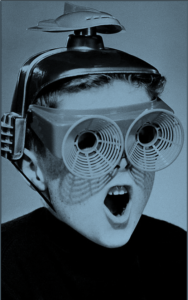 Future Boy dreams big. World Peace. Prosperity for All. Vacations on luxury cruise ships to exotic galaxies. Robots that bring cold beer and juicy cheeseburgers.
Future Boy dreams big. World Peace. Prosperity for All. Vacations on luxury cruise ships to exotic galaxies. Robots that bring cold beer and juicy cheeseburgers.
But how do we get from Here to There? History is full of larger-than-life political and business leaders. Jefferson and Madison fathered the Declaration of Independence and U.S. Constitution, Watt gave us steam power, Edison gave us electric power and light, and Ford gave us the automobile. And Google’s giving us the driverless car.
Or are they? Their cute little pods putter around Palo Alto sans drivers, steering wheels and brakes. More than just cars without drivers, these are something quite different. Google envisions a Big Step. Why waste time with little steps – take a big leap directly into the future of transportation. One day we’ll all decide to scrap our old-fashioned vehicles all at once and suddenly no one ever has to drive again; we’ll be living in a new Utopia of effortless transportation.
To the mathematical mind of an engineer, it’s a perfect plan. Efficient. Zero wasted effort. Zero wasted time or money.
But has the Future ever arrived in an instant? Plenty of times it seems that way. Sputnik suddenly orbits the earth. Automated teller machines appear on every corner. The Berlin Wall falls. Everyone gets a mobile phone.
In reality however, the path is never a short straight line – it’s a long and winding road littered with dead ends. Edison tested hundreds of materials before finding a suitable filament for the electric light. Then it took huge investments and thousands more experiments and prototypes to create the lights, the wires, the dynamos, and all the sundry pieces of equipment to deliver power to homes and businesses.
It’s the same with every other “sudden” innovation – it’s long, hard, backbreaking work peppered with one disappointment after another. In these cases, the effort was eventually rewarded. But we rarely learn of (or soon forget) the work and expense put into the effort and the thousands of competing efforts that failed. The one winner takes all the glory.
Only in hindsight does the eventual path to success seem obvious. There are no shortcuts to the Future. It must evolve from the Present.
The “horseless carriage” presented innumerable problems to its users. But one by one people found ways to address the problems. Electric starters, brakes, transmissions, headlamps, windshields, windshield wipers, cup holders – one by one new components were added or invented. Bit by bit, model by model, the horseless carriage evolved into the modern automobile.
And with each little step, people gradually got used to the new way of doing things. And with each step, the manufacturers learned a little bit about what worked and what didn’t. New features evolved while others withered and died.
People are happy to take little steps. They fear big leaps. Would YOU have wanted be the first passenger to ride in the first elevator (or lift, for our British readers)? Would you take the word of the engineers who tell you their new product is perfectly safe? Would you be the first to ride alone on a busy highway in an autonomous car? Or would you rather have an engineer with you to man the controls?
Those engineers riding along in today’s self-driving vehicles are the modern equivalent of early elevator operators. Passengers felt safe with an attendant there to keep them company. Were they needed to operate the machinery? Not really. Passengers could have learned to do that themselves, and today we all do. But those operators were a vital step in the evolution of the invention.
So I see few Big Leaps to the future in any area of our lives. The Future will sneak up on us, one evolutionary baby step at a time, like it always has.